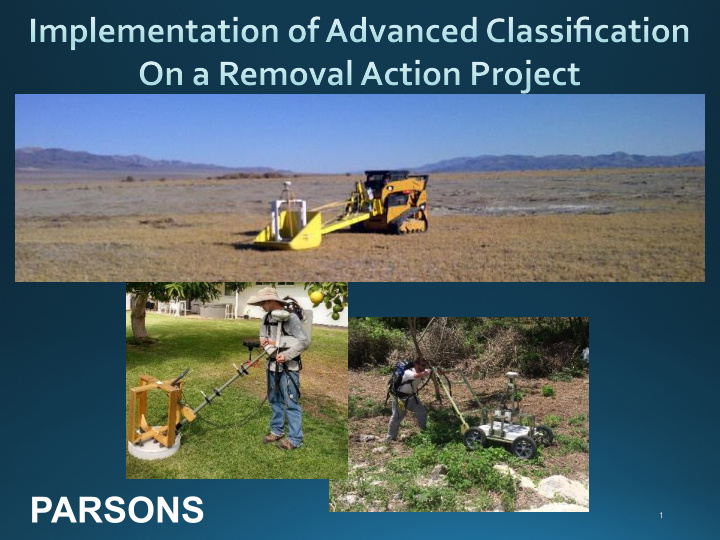



PARSONS
• An electromagnetic induction (EMI) metal detector (EM61) – is the current industry standard for identifying subsurface metal • Single transmitter fires and produces a current in subsurface objects • Single receiver records 4 measurements of secondary magnetic field created as the current decays • Response highly dependent on orientation of object
• Multiple transmitters, either offset or in orthogonal orientations MetalMapper • All include multiple tri-axial receivers positioned across the anomaly 0 1 EM Sensor 3 2 TEMTADS
• Dynamic or static (cued) • Dynamic uses Z-direction transmitter and all receiver orientations • Cued uses all transmitters and receivers, also includes stacking • Response measured for each axis of source rather than just the axis facing the receiver • Response measured ~20 times after each transmit pulse for dynamic data and from 50 to over 100 times for static
• Improved delineation for multiple small sources in high density areas • Improved positioning • Later time gates can reduce response from small, near surface sources • Data can be modeled; potential reduction in targets for cued survey • Relatively slow
Primary axis response Secondary axis responses
Results are a measure of the degree of match between an unknown target and a known signature in the library; expressed as a decision metric. High matches are investigated; low left in ground Good Match Poor Match
MetalMapper Classification Feature Space - Camp Sibert 0.16 4.2"mortar(seeds,library,test stand,GPO) 0.14 4.2" Mortar (seeds,test stand)- deep (>36") 0.12 UXO (4.2" mortar) Livens (test stand) 0.10 Decay MedISO (Seed) 0.08 2.36"Rocket(GPO&Library) 0.06 Sibert Target 0.04 Nose frag Half Shells/Large Frag 0.02 Base Plates Small frag 0.00 -2.00 -1.00 0.00 1.00 2.00 3.00 Size
Target Conf Dig Comment ID 472 -9999 Y Inconclusive 115 .97 Y Can Analyze: 105mm 23 .96 Y Can Analyze: 105mm Y 303 .96 Can Analyze: 37mm Dig 15 … Y Can Analyze: 155mm Threshold 300 .79 0 Can Analyze: Horseshoe 0 41 .79 Can Analyze: Horseshoe 0 2 .78 Can Analyze: Likely clutter 131 … 0 Can Analyze: Likely clutter 77 .03 0 Can Analyze: Likely clutter 0 78 .03 Can Analyze: Likely clutter 0 21 .02 Can Analyze: Likely clutter 222 .01 0 Can Analyze: Likely clutter • Verification digs – typically 200 past last TOI • Validation digs – chosen by PDT, also typically 200
• Costs dominated by digging scrap § § • 146 UXO in >500,000 digs • Only 0.03% were UXO UXO Item
• Size § § § • Diversity § § § • Composition § §
• Very High EM61-MK2 § § • High, But Not That High § § • Relatively Low § MetalMapper § • TOI Density vs Clutter Density
• Terrain § § • Vegetation § § § § • Environmental Interference § § • Area Closures or Sensitive Sites § § • Evacuations
• MetalMapper MetalMapper § § • TEMTADS / MetalMapper 2x2 § § § § TEMTADS • MPV § § § MPV
• Stakeholder input § UXO Item §
• Two large TOIs; few native TOI • EM61 towed array used for all but 6 acres of dynamic data collection over 198 acres • Flat and open; little geologic variability • NMED and EPA on board from start • AC eliminated need for closure of nearby airport; no residential evacuations necessary • Eliminated need for scrape and sift at target center; 94% reduction in digs
• 20mm to 5-in projectiles, mortars, rockets, grenades • Pacific island jungle; extensive brush cutting required • Significant effects from across-site geologic changes • High native TOI rate; deformed and deteriorated TOI • Dynamic production slow but improved results from EM61 • 46.5% dig rate; cued data collection and classification deemed more expensive than digging everything
Recommend
More recommend